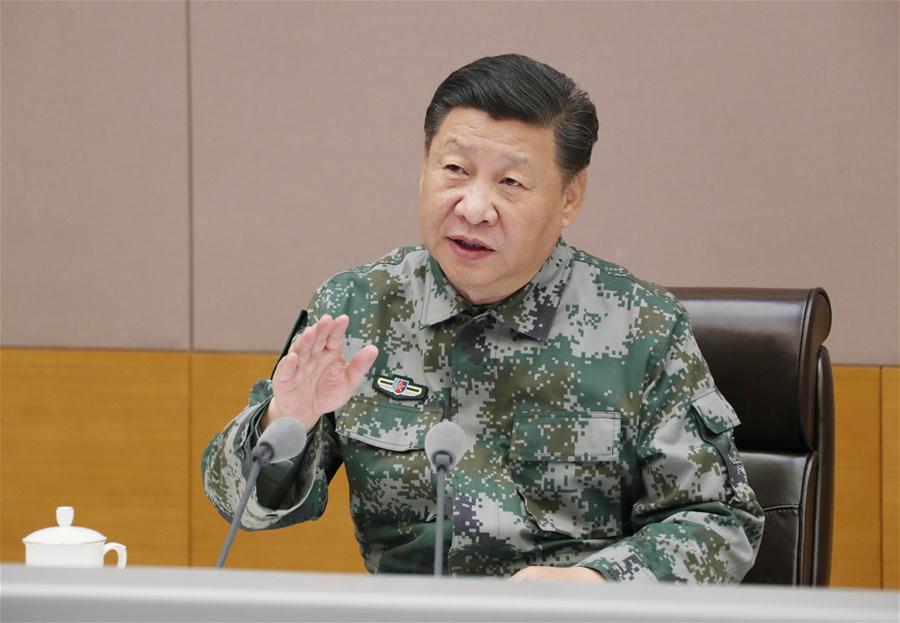
Chinese President Xi Jinping, who is also general secretary of the Communist Party of China Central Committee and chairman of the Central Military Commission (CMC) and commander in chief of the CMC joint battle command center, speaks during his inspection tour to the command center on Nov. 3, 2017. Xi Jinping on Friday instructed the armed forces to improve their combat capability and readiness for war. (Xinhua/Li Gang)
On the eve of President Donald Trump’s first state visit to China, President Xi Jinping made a drastic foreign policy reversal. Beijing would bury the hatchet with Seoul despite its hosting of the Terminal High Altitude Area Defense (THAAD) system. This diplomatic rapprochement would put the sophomoric Trump White House in a morally challenging position on possible war with North Korea.[ST1]
The growing trade and economic relations between China and South Korea are not the only reasons for this policy reversal. Apparently, China has now gained a friend—while President Trump tweets negatively on South Korea’s leadership and its trade with the US. Soon after the 19th National Congress of the Communist Party of China (CPC), Beijing also signed several trade and investment agreements with Russia.
These two diplomatic endeavors sends a clear message to Washington that the United States is no longer the leader on global issues.
Three Revolutions
These diplomatic maneuvers display Xi Jinping’s Thought, which is now enshrined in the Constitution of the CPC. It may be called the modern “Communist Manifesto” for the New Era, or China’s “Third Revolution”.
The First Revolution started with Chairman Mao Zedong’s Cultural Revolution and Great Leap Forward, which sought to get rid of the backward feudal society. The founding generation of the PRC considered China’s dynastic heritage an outdated relic of Confucian traditions and a stumbling-block for modernity. The republicanism that ensued under Dr. Sun Yat-sun and General Chiang-Kai-Shek was also viewed as a transplant of Christian missionaries, Western doctors, and English educators. Mao’s efforts eventually caused disaster and tragedy for China.
With Mao’s passing in 1976, the Second Revolution was engineered by Deng Xiaoping. His economic reform and trade liberalization unleashed the entrepreneurial zeal of the Chinese people. Within one generation, Deng’s Revolution made China a manufacturing powerhouse and the largest economy after the United States.
President Xi—with his consolidation of absolute power as the “chairman of everything” from the Party, state, military, economy, and most importantly, culture—sends the message that China now has the confidence to rejuvenate itself. This is the Third Revolution, which aims to create a “moderately prosperous society.”
The Confucian Party of China
The CPC is Communist in name-only, but Xi’s socialism resonate with the egalitarian ideas that Mao espoused through his First Revolution.
President Xi’s rejuvenation of Chinese culture with Confucian values is the hidden message of the New Era. It would reinvent the Communist Party into the Confucian Party of China—the New Era of the CPC.
The Confucian vision of cultural confidence is now combined with Deng’s capitalist economy with Chinese characteristics; i.e., running the economy with the “visible hands” of the State-Owned Enterprises (SOEs).
The Third Revolution aims to restore China’s ancient “Confucian” culture of hierarchical authority that Mao tried unsuccessfully to destroy, and to continue Deng’s market reforms by giving primacy to SOEs, with Xi as the chairman.
Confucian Democracy?
President Xi’s notion of “concentrated power” is antithetical to the democratic values of the West. It is natural for the Western media to characterize Xi as a strongman.
Xi may not have the personal charisma, innate intelligence, and practical wisdom of Chairman Mao. Yet Xi, like Deng, is a transformative leader.
During his first term, President Xi promoted Confucian values as part of the Chinese DNA. Confucian teachings are now spreading through China and the rest of the world. All these things were made possible by Deng’s openness and market reforms, as it gave China a solid treasury to spend on Xi’s projects like the Confucius Institutes and the Belt and Road Initiative. It seems Xi will continue Deng’s approach of openness and globalization as he reaffirmed at the World Economic Forum in Switzerland earlier this year.
Given that the other Politburo Standing Committee members are all in their 60s, Xi’s presidency may exceed the usual term Testing Confucian Governance
In all this, there seems to have obvious parallels between the hierarchical aspects of Confucian ethos in the Chinese DNA and the authority aspects of Communist ideas imported from the Marxist-Leninist ideology. This formula may work in China for now.
President Xi must address two major issues:
.First, China must at least sustain its current economic growth to alleviate poverty and provide employment opportunities, especially for young people. .Second, China must restore Confucian ethics. This is being tested in lethargic bureaucracies as the anti-corruption campaign further demoralizes the civil service. The cherished traditions of family relationships are also breaking down as the divorce rate is increasing to an unprecedented degree, and more and more independent-minded children are now acting more like “Bananas” (Yellow outside, but white—and Western—inside) than traditional Chinese.
The all-powerful Xi has reversed his policy on South Korea soon after signing a bilateral treaty with Russia. It is a clear signal to Washington and the world that President Xi’s Thought means a new kind of global leadership.
